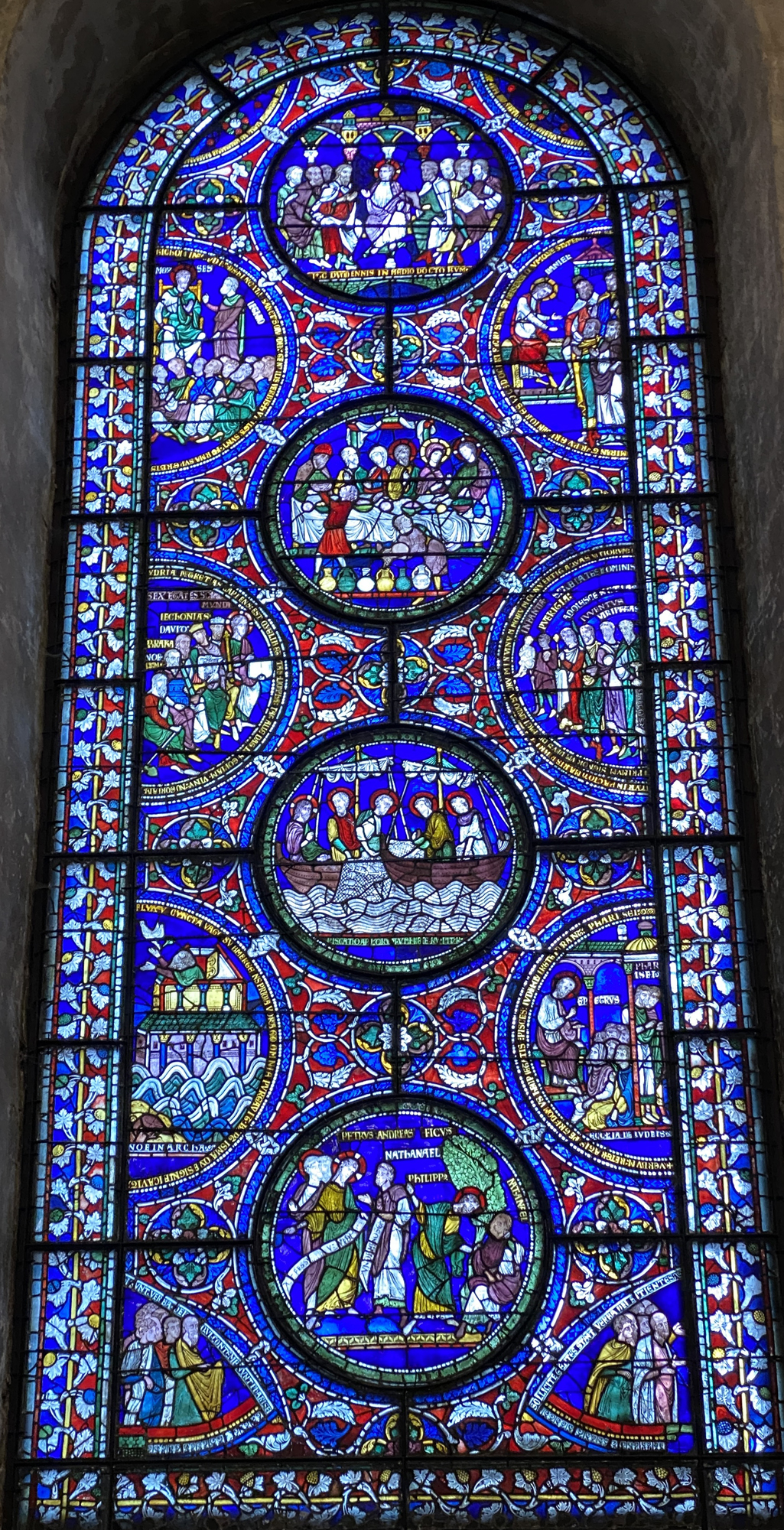
Jesus Window
13th century
Stained Glass
Canterbury Cathedral
From top to bottom, the large roundels are as follows:
-
The boy Jesus among the Doctors (Luke 2:41-52). As usual, the scholars are pictured as old men. The book in the hand of the one on the far right relates to their "lectures on the Law" that the Infancy Gospel of Thomas says Jesus was discussing at the time.
The two half-roundels flanking this first image illustrate Old Testament episodes in which similarly youthful precursors of Christ come to the defense of innocent women. Both of them emphasize the young person's status as a precursor by putting him on a dais like the one in the central image. The picture on the left has two figures labeled as Moses and Jethro, the priest of Midian. In Exodus 2:15-22 Moses defends Jethro's daughters from a nasty group of shepherds, and Jethro calls him a "great-hearted youth" (Glossa Ordinaria II, 391). The image may also refer Jethro's blessing Moses (Exodus 4:18) when the latter says he will return to Egypt to free his people, who are pictured at the bottom of the image.
In the right half-roundel a young-looking figure labeled "Daniel" addresses a group of four men. The cathedral's label identifies this as "the youthful Daniel come to judgment." Most likely the picture represents Vulgate Daniel 13:1-60, where the boy Daniel comes to the defense of Susanna. She had been falsely accused of adultery by two lecherous elders. The two men in the foreground may be those elders; their clothes are identical in color to the those of the "Pharisees" who reject the gospel in the third of the roundels on the right.
-
The Miracle at Cana (John 2:1-11). When the wine runs out at the wedding Jesus changes six stone jars of water into wine. In the image Mary tells Jesus that the wine has run out. Jesus then tells the servant in purple to put water into the jars. He does so, and then the servant in red hands the headwaiter a jar of what is now wine.
Jesus' disciples were also at the wedding, and the man with the halo seated on Mary's left is one of them, perhaps John himself, traditionally considered the author of this gospel.
The half-roundel on the left follows St. Augustine's interpretation of the six jars as representing the six ages of man: the first age represented by Adam, the second by Noah, the third by Abraham, the fourth by David, the fifth by John the Baptist, and the final age by Christ himself. The half-roundel on the right extends the interpretation by picturing the six ages of man from infancy to old age.
-
The Draft of Fishes (John 21:4-7). Jesus is on the left, instructing the disciples to put their net in the water. In the center, the disciples pull up the net, which is full of fishes. In exegeses of this passage the great number of fish signifies "the great multitude of those who came to believe through the preaching of the Apostles" (Glossa Ordinaria V, 1331-2). Accordingly, the right half-roundel shows St. Peter preaching to "the Church of the Jews" while the one on the left pictures Noah in the ark (Genesis 8:1-12), which is traditionally taken as a type of the Church. Further, those who spurn the Church are represented by the two Pharisees shown walking out of Peter's sermon and by the raven pecking on a dead body in the lower left of the Noah image. (See our Noah page, notes 1 and 2, for the traditional interpretations.)
-
nathaniel becomes Jesus' disciple (John 1:43-50). The image gives two consecutive moments in the narrative. On the right, Nathanael is under the fig tree when Philip tells him that he has found "him of whom Moses in the law and the prophets did write, Jesus the son of Joseph of Nazareth." On the left, Nathanael has come to Jesus, who says he had seen him under the fig tree. Nathanael then says "Rabbi, thou art the Son of God, thou art the King of Israel."
The two half-roundels at the bottom continue the window's theme regarding those who accept the gospel and those who reject it. On the right is the Church of the Gentiles, of whom the inscription says sollicite gentiles stant verba dei sitientes, "The Gentiles stand sollicitously, thirsting for the words of God." In contrast, the inscription in the other half-roundel saya, [h]i sunt verba dei qui contempsunt pharisei, "These are the Pharisees who despise the words of God."
View this image in full resolution.
Read more about images of the child Jesus in the Temple.
Read more about images of the miracle at the wedding at Cana.
Read more about images of Noah, Daniel, and Moses.
Read more about images of St. Peter and St. Philip.
Photographed at the site by Richard Stracke, shared under Attribution-NonCommercial-ShareAlike license.
